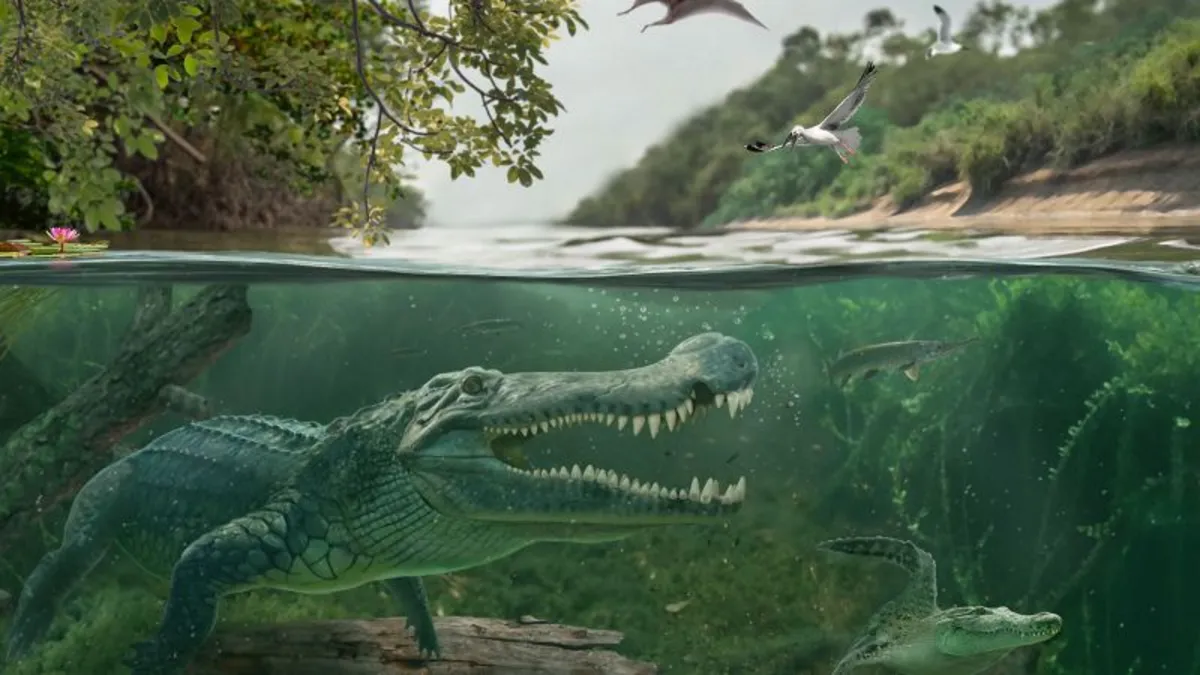
Sign up for CNN’s Wonder Theory science newsletter to explore the universe with intriguing news on groundbreaking discoveries and scientific advancements. A recent study has revealed fascinating insights into Deinosuchus, a massive, extinct reptile that once roamed the earth alongside dinosaurs. This colossal creature, with a broad snout reminiscent of an alligator’s, thrived due to a unique trait that modern alligators lack: its ability to tolerate salt water.
Deinosuchus was one of the largest crocodilians to ever exist, boasting a body length comparable to that of a bus and teeth as large as bananas. It dominated the rivers and estuaries of North America during the Late Cretaceous period, approximately 82 million to 75 million years ago. Its skull was both wide and long, featuring a distinct bulbous structure that set it apart from other crocodilians.
Evidence of Deinosuchus’ predatory behavior can be found in toothmarks on Cretaceous bones, suggesting that it hunted or scavenged on dinosaurs. Despite its menacing name, which translates to “terror crocodile,” it has often been referred to as a “greater alligator.” However, new research indicates that Deinosuchus may occupy a different branch of the crocodilian family tree than previously thought.
Recent analyses combining fossil evidence with DNA from contemporary crocodilians like alligators and crocodiles have led scientists to reassess the evolutionary relationships of Deinosuchus. Unlike its alligatoroid relatives, Deinosuchus retained salt glands inherited from ancient crocodilians, enabling it to thrive in salt water. This adaptation likely allowed it to navigate the Western Interior Seaway, a vast body of water that split North America during a greenhouse phase characterized by rising sea levels.
By possessing salt tolerance, Deinosuchus could inhabit coastal marshes on either side of the ancient inland sea, making it a widespread predator capable of dominating marshy ecosystems. Senior study author, Dr. Márton Rabi, emphasized that “no one was safe in these wetlands when Deinosuchus was around,” highlighting its formidable size, estimated at over 26 feet (8 meters) in total body length.
Fossils of Deinosuchus have been discovered on both sides of the ancient seaway, belonging to at least two species. The larger species, Deinosuchus riograndensis, thrived along the western edge of an island known as Laramidia, which was bordered by the Pacific Ocean. This distribution raised questions about its classification as an alligatoroid, as these modern relatives are primarily freshwater dwellers.
One hypothesis suggested that early alligators might have been saltwater tolerant but lost this trait over time. However, the evidence supporting this idea was limited, primarily based on previous classifications of Deinosuchus within the alligatoroid group. Contrary to this, the new analysis reveals that saltwater tolerance is an ancient trait among many crocodilians and was lost in the alligatoroids.
The study’s new family tree for crocodilians sheds light on the ecological flexibility of these creatures. According to Dr. Evon Hekkala, a professor at Fordham University, this adaptation would have allowed crocodile lineages to be more opportunistic during drastic environmental changes, such as sea level rise, which often led to the extinction of less tolerant species.
Utilizing both molecular data from modern crocodilians and morphological analysis, researchers constructed a clearer picture of Deinosuchus’ evolutionary history. The study found that early alligators were significantly smaller than other contemporary crocodilians. The emergence of larger body sizes in alligators occurred approximately 34 million years ago, after climate changes led to the extinction of their competitors.
In this context, Deinosuchus stands out as an outlier. Its massive size likely placed it on a different evolutionary branch before the alligatoroids evolved. This new perspective aligns with current understanding of the ecological roles of both extinct and living crocodiles.
While Deinosuchus was one of the largest crocodilians, it was not unique in its size. The study indicates that massive crocodilians evolved independently in various aquatic environments over the past 120 million years, adapting to different global climatic conditions. Reports of modern crocodiles reaching lengths of over 23 feet (7 meters) further illustrate that large sizes may have been the norm rather than the exception in crocodilian evolution.
As Dr. Rabi concluded, “Giant crocs are more like the norm — of any time.” This ongoing research not only enriches our understanding of Deinosuchus but also opens up new discussions about the evolutionary and ecological significance of these magnificent reptiles.